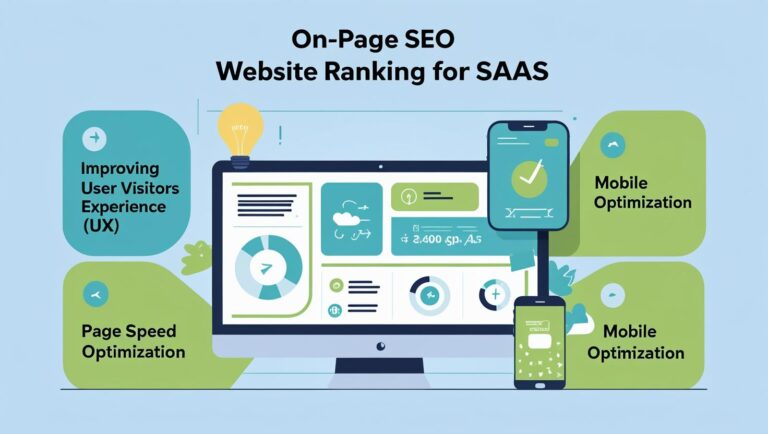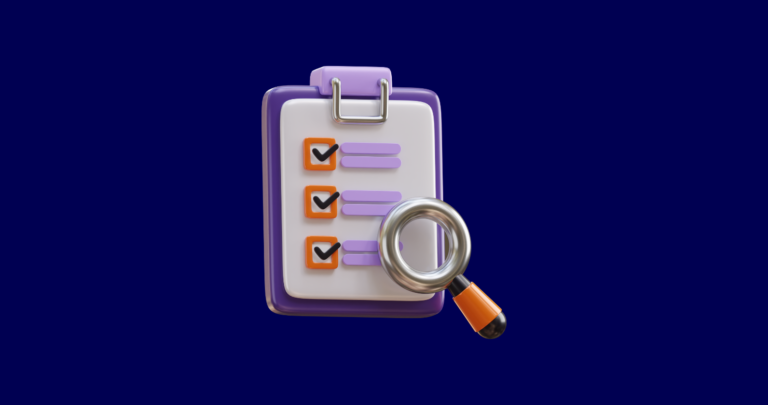SaaS SEO Audit
In today’s fast-paced SaaS industry, your website is your window to the world and the first point of contact for your clients. But it’s not enough just to have a website, it should look great in the search results to attract the right customers. A Google algorithm update means that there is a need to address your site in order to rank it well even amongst your competitors. And that brings us back to our need for a thorough SaaS SEO audit.
You may consider an SEO audit as a check-up for your website that allows you to identify certain problems a visitor might encounter. This includes checking all the technicalities, your content and material, and even your backlinks. For SaaS businesses, this is especially important because you are working with fast-paced changes in the industry, B2B sales with long cycles, and high expectations of companies for your product.
This guide will cover every bit of a SaaS SEO audit – the technical bits, audacious content, and off-page signals. At the end of the course, you’ll have concrete steps to improve your site and increase traffic, conversions, and repeat business. Let’s begin!

What is a SaaS SEO Audit?
Performing a SaaS SEO audit is like taking your website to the doctor for an SEO checkup. Namely, it is a process of finding out what processes are strengthening and which are weakening the company. Then we will go over statistics: in technicalities, your content, those great backlinks, and the usability of your site. The ultimate goal? To assist you in ensuring that your website is among the topmost levels that can be seen by the potential customers.
Research indicates that 53% of all visits come through the organic search which makes the organic search the most popular source from paid search, social media, and display advertising. This shows why it is critical to conduct a search engine optimization audit at least once in a while to ensure that businesses do not lag behind in the search engine result pages.
As mentioned above, out of all the elements involved in SaaS SEO, the SEO audit is the one that allows organizations to achieve the most objectives. Here are SaaS SEO tools to improve your website’s ranking and drive more traffic.
Key Components of a SaaS SEO Audit
- Site Architecture: How effective are the page’s configurations and how are they interlinked?
- Indexability: Does your content rank easily in search engines and can search engines crawl and index your content?
- Keyword Optimization: Are you targeting the right keywords that fit the first what your customers may be searching for?
- Backlink Profile: How many quality websites are linking to yours?
- User Experience (UX): Does your site load quickly? Is it friendly to mobile users? Can your visitors find what they’re looking for on your site?
Why is SaaS SEO Audit Important?
- Uncover Hidden Issues: It will discover things like slow page speed, a weak keyword strategy, or bad quality backlinks that affect your site badly.
- Optimize for Search: Ensure that your website is in good health so that search engines can find your content and rank it appropriately.
- Boost Conversions: Optimize user experience so customers can glide through your funnel successfully and become paying clients.
- Stay Ahead of the Competition: Strong SEO is a must and you should make sure you always stay several steps ahead of your competition.
How to Perform a Technical SEO Audit?
A technical SEO audit is fundamental to any great SEO plan to implement, especially for SaaS organizations. Indeed, a speedy, finely-tuned website can go straight to conversion rates. The aim is to ensure that Google and other search engines can index, crawl, and rank your website. Also, we will help you identify any issues that might slow your website – slow-loading pages, broken links, or a bad mobile design.
Here’s a step-by-step guide on how to conduct a technical SEO audit for your SaaS platform:
1. Check for Crawlability and Indexability
First and foremost, ensure that Google and other search engines can find and crawl most or all of the critical parts of your website. If they can’t “crawl” your site, your content will not appear on the search engine results page even if it is good.
2. Audit Site Speed and Core Web Vitals
Site speed matters – a lot. It influences the way Google indexes your site, as well as the level of satisfaction of each visitor to your site. People are more likely to leave the page (i.e., bounce rates) and your site’s ranking will be lower, particularly on mobile devices. Google’s Core Web Vitals focus on three key areas: how quickly the page actually loads, how quickly the page becomes interactive, and how flicker-free the page is.
Google shares insights on mobile that 50% of the visits to mobile sites are abandoned if the site’s loading time is more than 3 seconds.
3. Review Site Architecture and Internal Linking
The layout of your website determines how quickly individuals and search engines can navigate through the site. Properly organized and formatted site format allows search engines to determine the site hierarchy, and properly index it.
4. Fix Duplicate Content and Meta Tag Issues
Duplicate content also misleads search engines in the process and is bad for your rankings. And if your meta tags (those short descriptions that appear in the search results) are not optimized, then you are missing traffic.
5. Evaluate Schema Markup
Schema markup is a kind of code that informs search engines about what your content is all about. By using it, you improve your likelihood of coming up in those flashy “Featured Snippets” at Google, like review excerpts or product specs.
A Quick Recap of Technical Audit Actions
- Google Search Console is an excellent tool to check the crawlability and indexability of your pages.
- Optimize the page with the help of PageSpeed Insights and other tools, moreover, pay attention to the Core Web Vitals.
- Review the internal linking of the site since most internet users get frustrated with complex site structures.
- Take care of problems with identical content with the help of canonical tags and distinct meta tags.
- Use schema markup so that search engines can easily interpret your content.
On-Page SEO Audit Process
On-page SEO audit is one of the best ways of making your website’s content perfect for both search engines and human viewers. It primarily includes features such as title tags, meta descriptions, the quality of the content, the number of times you have used keywords, and the internal links. Having an effective on-page SEO means making large improvements on the page’s ranking, and assisting users in making their purchase decisions.
Here’s a step-by-step guide to conducting an on-page SEO audit for your SaaS website:
- Optimize Title Tags and Meta Descriptions
Meta tags and title tags optimization acts as an index of your website in search results. It informs search engines what every page of a website is all about and can determine whether a particular user will click on your link or not. According to the study, Google’s top 10 ranked pages contain 65% to 85% of the targeted keywords in their title tags.
2. Conduct a Quality Content Audit
The quality, relevance, and helpfulness of information to the people are paramount. It can be seen as producing content that people are interested in reading in their spare time. This means content optimization is the key to delivering high-quality content.
3. Review and Optimize Heading Tags
Heading like H1, H2, H3, and others make the content structure simpler for both the readers and the crawler to comprehend.
4. Check Internal Linking and Anchor Text
Internal links are one of the most important elements of on-page optimization. It explains the relationship between your pages to search engines and reveals their importance. It also directs the visitor to more information, thus helping the user stay longer on your website.
5. Audit URL Structure
URL optimization is a clean and great URL arrangement when it comes to SEO ranking as well as the user.
6. Optimize Images and Media
You need more interesting and appealing content on your site and it requires proper image optimization. If not optimized, they can result in a slow site speed, which you can review in the page audit.
A Quick Recap of On-Page SEO Audit
- Make sure that all such titles and descriptions contain different keywords and reflect the intent of a user.
- Review your content through audit for relevance, frequency, and compliance with search intent.
- Organize your content with the help of proper heading tags- Heading 1, Heading 2, Heading 3, etc.; for both users and search engines.
- Begin with relevant anchor linking between various pages of the site so as to simplify site navigation and enhance SEO operations.
- Use URLs that are short, and to the point. Use proper alt tags while maintaining the image size to enhance the site’s speed and SEO.
Backlink and Off-Page SEO Audit
Off-page is considered as the method to build the reputation of your website among other competitors. It is all about the events that are taking place beyond your site that determine your authority and the search position of your website. Back-link is a significant part of this: they are like recommendations from other websites saying to search engines that your site contains valuable content etc. A comprehensive off-page SEO audit also includes social media activities, brand discussion, and local SEO issues if any for the firm.
Here’s a step-by-step guide to conducting an off-page SEO audit for your SaaS website.
1. Backlink Analysis
This shows that while backlinks are still important in the current SEO models, the number isn’t as crucial as the quality of the link. It is better to have numerous links linking to you from well-regarded sites rather than having hundreds of links coming from dubious sites. Backlink auditing helps you distinguish between useful and useless backlinks for your ranking.
Ahrefs shows that 90% of internet sites have no organic due to the absence of backlinks.
- Evaluate Link-Building Strategies
Once you know where you stand with backlinks, it is time to adjust and improve your link-building strategy. Acquiring high-quality backlinks is not a one-time thing, it is a continuous process.
3. Social Media Engagement and Brand Mentions
Even though sharing on such social networks and getting more likes will not affect your rank in any way, they do make the brand more popular and can even bring traffic to the site. Topics that go viral are likely to receive more backlinks than topics that are simply read online.
4. Competitor Off-Page SEO Audit
Comparing the backlink profile and running competitor analysis will indicate what opportunities you are leaving on the table. Still, it is like getting a glimpse of what you might be doing right from their side of the table.
5. Assess Local SEO (If Applicable)
For most SaaS businesses, local SEO isn’t a major focus. However, if you have a physical location or have a special niche and your target audience is geographically limited, it makes sense to check the local SEO position.
A Quick Recap of Backlink and Off-Page SEO Audit
- Evaluate the quality and the extent of your backlinks and mark any conspicuous link as a toxic link.
- Employ strategies like broken link building and competitor link analysis to improve your backlinks.
- Monitor social activity and collect data about brands you may use to increase audience attention.
- Conduct an off-page search engine audit in order to identify weaknesses that your competitor might have.
- If applicable localize your SEO to attract local customers using services such as Google My Business and local links.
Manual SEO Audit
Automated SEO tools are superb but there are times that one has to do it manually. A manual audit gives you an opportunity to explore aspects such as usability, quality of content, and user experience in detail. Here is a guide on how you can bring that human angle into your next SaaS SEO audit.
- Take Your Website for a Test Drive
When you are next using the site, act as the visitor using it so that you can see what they see. Are you capable of locating your primary product categories from the home page without much of a hassle? Are internal links useful? Are users able to locate the key information they are looking for without getting lost? The aim is to ensure that users are not struggling to move through the different stages of your sales funnel.
- Check Your Content’s Quality & Relevance
Spend some time reading through your key product pages and blog posts. Is the content really addressing the questions your audience has? Is it current or is it time for an update? Ensure your content is easy to read and navigate. It is so valuable that your readers can use it.
- See How Your Site Looks on Mobile
Take your phone and possibly a tablet or two, go to your website and try to feel how it is to work with it. Can people easily navigate? Are images and forms appearing normally? As you are aware, mobile traffic is enormous, so a mobile-friendly design is essential.
- Double-Check Your Backlinks
Examine some of your best-performing backlinks more carefully. Go to those websites and check whether it’s legitimate and fit into your niche. The purpose is to ensure that your backlink profile is full of good quality links that improve the authority.
- Fine-Tune Your Meta Tags & Titles
Check the title tags and meta descriptions of the most valuable pages manually. Are they tailored and interesting? Are the keywords you want to rank for included in a proper way? Remember these are the bitesize pieces that users see in a Google search, so ensure that they are compelling!
A Quick Recap of Manual SEO Audit
- Perform the manual navigation review to check the level of the site’s usability.
- Do a manual examination of the content quality to check if it meets the user’s demand.
- Conduct the mobile UX audit by visiting the site on various mobile devices.
- Perform a manual check of your backlinks profile and the quality of the links you have.
- Check meta tags and title tags manually to check for keyword optimization and clarity.
Tools for Conducting an SEO Audit
In order to perform a competent SEO audit one requires tools. They will help them analyze the technical parameters, backlinks, the on-site components, and the general performance of the website. The right tools can make a ton of difference in terms of time, accuracy, specific insights, and even solutions. When you’re managing a SaaS business, the choice of tools can define whether you’ll get a rather usual audit or receive a boost to your website.
Here are the top tools you need to conduct a comprehensive SaaS SEO audit:
- Google Search Console
This free and must-use tool allows you to see how your site is doing in the Google search engine. By using this tool, you get to know about the indexing and crawling problems and the general health of your site.
- SEMrush
It is an all-round, easily recognizable SEO tool that offers numerous features of both onpages and offpages.
- Ahrefs
Ahrefs is also another effective SEO tool, which is especially famous for a rather broad range of options available for backlink analysis. But the software also offers a strong site audit feature.
4. Google Analytics
This free program is a must when it comes to analyzing your website traffic. Although it is more than an SEO tool, it gives helpful information on how your site is ranking.
5. Surfer SEO
For anyone serious about taking their on-page SEO and content marketing to the next level, there is no better tool than Surfer SEO. It uses analytical information to assist users in producing content that can rank.
A Quick Recap of SEO Audit Tools
- For crawling and Indexing as well as information regarding mobile friendliness, use Google Search Console.
- Use SEMrush for conducting an extensive website assessment, keyword research, as well as backlink checking.
- Ahrefs includes a detailed backlink profile analysis and competitive research.
- Google Analytics is one of the best for tracking users’ behaviors and the sources of traffic as a measure of SEO success.
- Surfer SEO is best for content optimizers and the best tool for SERP checkers.
Common SEO Audit Mistakes
At the same time, even with optimal tools and plans for the SEO audit, it can turn into a failure. Many of these can result in a partial audit or even negatively affect your website. Let’s dive into these challenges and how to avoid them for a seamless SaaS SEO audit. Here are the key things to avoid when conducting an SEO audit.
Also learn about: Best Seo Agency for SaaS!
- Focusing Only on Technical Issues
Technical SEO is valuable but it is not the end of the process. Don’t be so obsessed with technical aspects such as page loading speed and mobile-friendliness, that you neglect factors such as relevance, readability, proper keywords, and whether your content fits the search query.
The Fix: Ensure that you do a complete SEO audit. At least one that comprehensively covers all the on-page factors, the content as well as the backlinks. This provides a comprehensive view of your website’s performance.
- Tackling Every Issue at Once
This is usually a very bad strategy because you’re trying to address multiple problems at once. It is rather time-consuming and ineffective when most of the time we are dealing with minor issues.
The Fix: Prioritize! Pay primary attention to the large problems such as broken links and the page load speed in addition to indexing problems. Tools such as SEMrush and Ahrefs allow you to sort and rank issues according to their risk level.
- Ignoring Mobile SEO
Everyone uses a phone to surf the internet nowadays. In case your site is not optimized for mobile devices, you not only deprive yourself of traffic but also can face Google penalties.
The Fix: Use Google’s Mobile Usability Report to identify and address problems related to mobile versatility. Your site should load very fast, and content should be viewable on several devices. Don’t forget about those Core Web Vitals as well!
- Overlooking Internal Links and Navigation
Internal links are similar to road signs on your website, directing your visitors and then search engines. It’s also important to look for “orphaned” pages that have no links from the rest of the site, or cases where content might be linked to inappropriately.
The Fix: The last step would be to audit internal links using a tool such as the Screaming Frog to identify pages that require some more attention and appreciation. Ensure that specific points lead to other critical areas within the page, it’s important to incorporate relevant anchor text that can be easily read by the users and to Google.
- Letting Duplicate Content Slide
If a search engine finds similar content on two sites, it gets confused and may rank them poorly. It is an avoidable issue and very much likely to go unnoticed during an audit.
The Fix: Use Screaming Frog and Ahrefs, or any other crawling SEO tools to check for duplicate content. Inform search engines which version of the page is primary using canonical tags, however, attempt to combine or simply eliminate such content.
- Failing to Track Progress Over Time
Technically, an SEO audit is not a one-time process. Without time tracking, it is possible to overlook the changes and there may be new problematic cases or areas for improvement. SEO is an ongoing process!
The Fix: Do SEO audit as often as monthly, but at most, it should be done quarterly. Monitor the site traffic on Google Analytics, the bounce rate and monitor keyword rankings on SEMrush.
- Neglecting to Review Competitor SEO Strategies
Nevertheless, do not confine yourself to your own Web site – find out what your competitors are getting up to. It is possible to gain some insight as to what they are doing and perhaps gain ideas for your own SEO program.
The Fix: Perform a competitor SEO audit using tools like Ahrefs or SEMrush or any other professional software. Analyze your rank to theirs by looking at backlinks, keywords, and most successful content. As you review them, you can easily discover weaknesses in your own strategy.
- Not Customizing SEO Audits for SaaS
SaaS businesses are different and have different requirements. Do not employ a universal SEO audit that may not be suitable for your niche. Generally, all SaaS businesses should spend their time on matters such as product training, customer satisfaction, and the nurturing of the sales process.
The Fix: Tailor your SEO audit towards what is relevant for SaaS businesses. Focus on how convenient and easy it is for the buyers to get through the purchasing cycle, and how effective your SEO campaigns reflect this process.
A Quick Recap of Common SEO Audit Mistakes
- It’s not just technical SEO, use on-page SEO and off-site SEO, and others within your website too.
- Organize all SEO problems according to their importance to proper SEO and their relevance to your website.
- Mobile SEO must always be taken in account especially when using mobile traffic increases.
- To improve both the usability and the read by the search bots, make sure that the site has a good internal link structure.
- It is also recommended that multiple content be checked on a constant basis to avoid any penalties.
- Monitor SEO on a regular basis to address problems and to grasp new features proactively.
- When searching for your own keywords, examine your competitors’ experiences and apply recommendations to improve your SEO.
- Specifically, adjust the audit for dealing with SaaS businesses while taking into account the current demands.
SEO Audit Report – What to Include?
You have followed all the right steps for conducting an effective SEO audit. It is now time to take that knowledge and provide a concise set of recommendations on how to increase the effectiveness of your websites. An SEO audit report is a guide to improving the position and traffic of the website or business. In this report, a SaaS company should get all of the details regarding the technical aspects, on-page and off-page features of the website, and a set of solutions for the website SEO.
Here’s a breakdown of what to include in your SaaS SEO audit report:
- Website Health Check
Be sure to begin your audit with an assessment of the overall status of SEO on your website. Consider it a status update of the performance of your site where it shows the success and failure.
- SEO Score: If you used SEMrush, Ahrefs, etc., include the score of your overall SEO health. This can act as a reference for future measurements as a way of comparing with the previous measurements taken.
- Key Issues: Highlight the areas that may require urgent attention such as having one or several broken links; slow page speed; or the inability to index pages correctly.
- Positive Findings: However, make sure to mention the areas where your site is already good: for instance, it has high-quality backlinks or ranking for certain keywords.
- Technical SEO Audit Results
This segment covers the features that determine how the search engines crawl and index your website.
- Crawlability & Indexability: Submit any problems that may prevent search engines from crawling or indexing your website. Specify which pages and clearly state how these issues can be solved.
- Page Speed: Post information about the speed at which the site loads and the areas in which you are underscoring the desired indicators of Google’s Core Web Vitals. Give some techniques that can make some difference, such as reducing image size or enabling the cache.
- Mobile Usability: If you discover any issues specific to Mobile Devices, mention them along with suggestions on how you can make your site more Mobile-friendly.
- On-Page SEO Checkup
Now, let’s consider the components within your website’s pages, such as content, keywords, and meta tags.
- Titles & Meta Descriptions: Check if there are any gaps in your titles and meta descriptions, if there are any duplicates, or if any of them need improvement to better fit your website. Offer suggestions for improvement, like adding relevant keywords or writing more compelling descriptions.
- Content Quality & Keywords: Review how well the content aligns with the target keywords and what people are looking for. Identify any areas of the page where you think; the content is out of date or not optimized well for keywords.
- Heading Structure: Find out if your headings (H1, H2, etc.) are placed correctly and help structure your content. Suggest any improvements for effective structure and readability.
- Backlinks & Off-Page SEO Analysis
Off-page SEO is crucial too. This section includes your backlink analysis and other factors that affect your ranking
- Backlink Quality: At the end of your analysis, make a summary of the quality and quantities of your backlinks. Identify those links that should be labeled as toxic and indicate how to gain additional high-quality links.
- Link-Building Opportunities: Identify other possibilities of getting backlinks such as; contacting other sites in your niche to link to your site or checking for broken links on other sites to link to relevant content on your site.
- Social Signals: If needed, discuss your social media experience and how many times your brand was mentioned. Provide tactics that could be implemented to boost off-page signals, if needed.
- Keyword Analysis and Rankings
This section gives information on how your website performs on distinct keywords.
- Top Keywords: Identify those keywords generating the highest traffic to your site together with their ranking. If possible compare your rankings with the competitors.
- Keyword Gaps: If you find any keywords that your competitors are targeting but you are not then highlight such keywords. Recommend making content for these keywords.
- Recommendations: Provide actionable recommendations on how to improve your keyword performance, like updating content, adding long-tail keywords, or chasing after new keyword possibilities.
- User Experience & Core Web Vitals
It is crucial to ensure a good user experience on your site since the new Google update is focused on Core Web Vitals.
- Core Web Vitals Report: Add your findings on metrics like First Input Delay (FID), Largest Contentful Paint (LCP), and Cumulative Layout Shift (CLS). Suggest ways to improve these, like decreasing load times or designing your page layout more stable.
- Navigation & Internal Linking: See how well you can navigate through your site and how comfortable it will be for a person to navigate Recommend changes to improve navigation and keep users engaged.
- Actionable Recommendations & Next Steps
The most important section of the report! Summarize the key problems you found and provide easy, step-by-step guidelines on how to fix them.
- Priority List: Develop a list of problems with their priority and criticality. It is important to address the major priority issues first – crawl errors, mobile user experience, and backlinks.
- Short-Term Actions: Introduce ideas that can be done immediately such as fixing broken links or improving meta tags.
- Long-Term Strategy: Explain a long-term SEO strategy where one needs to update content shortly, build links, and monitor keywords’ performance.
A Quick Recap of SEO Audit Report
- First, it provides an SEO health score of your site as well as brief information about important problems.
- Explain the results of the technical SEO check, including crawlability, site speed and Mobile Optimization.
- Review the findings about on-page SEO for areas like titles, content quality as well as internal linking.
- Evaluate your backlink profile and suggest measures for optimizing the off-page aspects of SEO.
- Ensure that you have done keyword analysis and research on the best keywords and those that your competitors are using and you are not.
- Analyze UX and CWV (core web vitals) metrics, suggesting how to fix slow loading and make your pages easier to interact with.
- It is necessary to present a list of changes to make and prioritize the possible steps toward improving the general SEO outcomes.
Best Practices for an Effective SaaS SEO Audit
An SEO audit is a good starting point but to get the best results, there are some useful tips to follow. This will guide you on how you can easily carry out the audit process and help you avoid some of the major mistakes. In this way, you’ll be able to come up with a perfect SEO plan for your SaaS business. Here’s How to Get the Most Out of Your SaaS SEO Audit:
- Perform Regular Audits
SEO is not a process that can be done once and forgotten. Search engines are dynamic and fluctuating most of the time, your competitors are also planning for a better SEO campaign. Performing audits regularly can also ensure you win future contracts and avoid problems.
- Customize the Audit for SaaS Needs
Every company is different and SaaS firms have specific requirements, so your audit should be likewise. Aspects like a product page, a freemium, and onboarding require unique approaches to the optimization of the pages and to getting the right user through the funnel.
- Use Multiple SEO Tools
To get a comprehensive overview of the website activity, use several tools at the same time. Each one has its strengths.
- Prioritize High-Impact Fixes
Not all SEO issues are equal. Of course, some fixes will benefit your rankings and traffic significantly more than others.
- Track Your Progress
Just like any other process, the audit of records is just the initial step. You must know how your changes are affecting your SEO progress eventually so that you can track your success.
- Ensure Ongoing Content Optimization
The significant thing is content, especially if you are in the SaaS industry. Therefore it is important to audit and revise the content. Refine it to make it more relevant, valuable, and updated to keyword searches.
- Monitor Competitors Continuously
SEO is a competitive game. Compete against them in the market and ensure you review their activities to identify chances now and then.
A Quick Recap of Best Practices for an Effective SaaS SEO Audit
- Conduct periodic SEO checks to avoid problems and to counter any changes made by the search engines.
- Adjust your audit for SaaS niche and target product pages, customer training, and managing sales funnel.
- To increase the efficiency of the topic analysis, use Google Search Console in combination with other SEO tools.
- The priorities should include crawl errors on a site, broken links, and page speed issues among others.
- Maintain SEO metrics and monitor the performance level constantly. Use key performance indicators toward your goal.
- Keep updating your content to incorporate new keywords. Ensure your pages match up with the latest keywords.
- Monitor competitors frequently to spot new opportunities and refine your strategy.
Final Verdict
Indeed, SEO is not an easy game at all, it is a process that begins on the day when an SaaS company appears and must be completed during its existence. The point is not to climb up the search results; it is about targeting those who may require the products or services that you offer. By consistently auditing your website, making data-driven improvements, and prioritizing user experience, you’ll create a powerful online presence that attracts and converts your ideal customers.
There is no simple one-for-all or get-rich-quick formula to make a website SEO successful. If you are committed and follow the right method, the results are remarkable. As the online industry develops, it is important to take risks, fix, and optimize what seems to work, and what does not, Your website is actually the core of your SaaS business. Give it the time it requires, and it will give back profitable growth, higher brand awareness, and a constant inflow of premium Traffic. So, what are you waiting for? Try our SaaS SEO audit today and experience the improvement in the organic traffic to your website.






